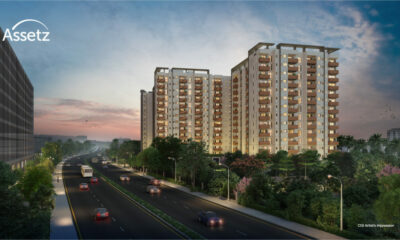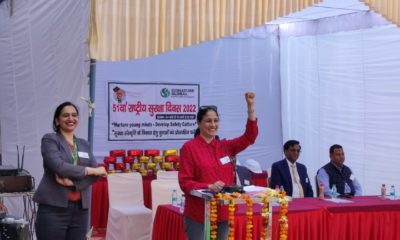Report
India’s residential sector poised for faster growth by Q4 2016: JLL


The following is the report by Ashwinder Raj Singh, CEO – Residential Services, JLL India
All indicators are towards a convincing revival by the end of the year
India’s residential property market has been going through turbulent times for past few years. However, things are looking up now with changes in the economy and various initiatives announced by the Government. To understand how various market forces have been making an impact, it is essential to look at the overall economic scenario in the country.
Economic Performance:
· FY 2015-16 saw Indian economy become the fastest-growing in the world with a GDP growth of 7.6 per cent. This, despite adverse global economic circumstances that put a lot of pressure on earnings, exports and overall development.
· The Government was able to contain the fiscal deficit to the budgetary target of 3.9 per cent, and is working on lowering it further to 3.5 per cent in FY 2016-17
· RBI has cut the key interest rates by 1.5 per cent since January 2015, and the Repo rate has come down to 6.5 per cent. This has started showing a visible positive impact on the economy. Industrial growth crawled back into the positive zone at 2.1 per cent in March ’16, crude oil prices stabilised at a favourable price band for India, CPI inflation decreased further at 4.83 per cent, and there are more-than-optimistic expectations for a good monsoon this year. Factoring all this in, the Indian economy looks well poised to grow at a healthy rate of 7.7-7.8 per cent. Though lower than expectations, inherent weaknesses in the system and inadequate infrastructure development continue to impede faster growth.
· FY 2015-16 saw traction in urban demand, and the current financial year is expected to usher in growth in the rural economy on the back of favourable monsoons. Agriculture contributes 15 per cent to the country’s GDP; and with 2016 being declared a ‘La Niña’ year, further growth is more or less assured. The impact of La Nina phenomenon on our economy is noteworthy. The average growth in GDP/Private Consumption/Investment on a year-on-year basis is 8.9 per cent/7.4 per cent/10.4 per cent during a La Niña year, compared to average growth of 5.8 per cent/5.2 per cent/7.2 per cent on a y-o-y basis in a non-La Niña year
· The signs of economic revival, along with foreign investment coming in the country, are evident in the share market offering 14 per cent returns over a 15-year period ending in March’16. FDI increased in the country by a whopping 37 per cent during FY 2015-16, going up to $39.2 billion from $28.78 billion in the previous FY.
Judging by how the economy is moving, there is definitely a rationale for positivity in terms of business performance. Let us take a closer look at how the residential real estate sector has been performing, and what lies ahead:
Real Estate Performance So Far:
· The real estate sector saw the worst phase in 2015-16 with sales and prices plummeting. High inventory levels, diminished demand and limited liquidity impacted new launches, as well. As per statistics, new residential project launches reduced by 6 per cent in Q1CY16 over Q4CY15. For FY 2015-16, the number of new launches stood at 1,81,294 units compared to 2,16,082 units in FY 2014-15, equalling a drop of 16 per cent
· Overall residential sales were down in the FY 2015-16 compared to FY 2014-15. As per recent data, 1,58,211 units were sold in FY 2015-16 vs. 1,61,875 units sold in FY 2014-15, which is a drop of 2.2 per cent. However, a positive twist to this otherwise grim situation is the rise in sales in Q1CY2016. This quarter saw a sale of 42,521 units compared to 39,001 units sold in Q4CY2015 – an increase of 9 per cent.
The Road Ahead:
Trends are beginning to change basis expectations of a good monsoon, revival in the economy, reducing inflation and the fact that residential prices have bottomed out. Also, the improving regulatory environment in the real estate sector, coupled with progressive Government schemes like Smart Cities, AMRUT and ‘Housing for All by 2022′, are beginning to have a positive influence. Additionally factoring in banks’ passing on of interest rate cut benefits to the ultimate consumers, the residential sector is all set for rebooted growth.
Where prices are concerned, there was stagnation or at best a modest rise by the end of FY2015-16. While Lucknow saw an increase of 16.1 per cent in the prices in Q3FY2015, NCR saw a price correction of 5% during April-June, 2015. Going forward, prices are expected to rise modestly.
The setting up of the Real Estate Regulatory Authority to ensure time-bound delivery of projects and more efficient and transparent dealings with developers point towards consumers gaining trust and coming back to investing in the market. A convincing start has been evidenced by the affordable housing segment, with this category witnessing increased traction on the peripheries of the major cities. Of the total sales, 60 per cent of the properties were priced below Rs. 5000/sq.ft. in FY 2015-16.
Global factors do have an impact, but India’s currently low inflation rate coupled with low interest rates and a surging economy will doubtlessly induce faster grow in the residential real estate sector in the mid-to-long term. Various additional factors point towards a more positive sentiment, including the stimulus that the recent Union Budget provided to both the supply and demand sides, improved funding for the industry and the clearing of roadblocks on REITs. The most convincing signs of revival should be visible in the last quarter of 2016 or by the first quarter of 2017.
-



 News3 weeks ago
News3 weeks agoKW Delhi 6 Mall Onboards New Brands
-



 News3 weeks ago
News3 weeks agoManasum Senior Living Launches IKIGAI GOA, A Senior Living Community in North Goa, in collaboration with Prescon Homes
-



 News2 weeks ago
News2 weeks agoGodrej Properties Sells Rs 3k cr+ Homes of Godrej Zenith, Gurugram, within 3 days
-



 News3 weeks ago
News3 weeks agoBridging India Divide: Top 5 Tier- 2 Cities to Focus On
-



 News3 weeks ago
News3 weeks agoCommercial Realty Gets Tech Savvy: Fast Construction, Enhanced Convenience
-



 News3 weeks ago
News3 weeks agoMultipoint Connection – A Definite Boon
-



 News2 weeks ago
News2 weeks agoRBI’s Status Quo on Key Policy Rates to Help Maintain the Real Estate Growth Momentum, Say Industry Stalwarts
-



 News3 weeks ago
News3 weeks agoSacred Cities See a Retail Boom as Spiritual Tourism Surge: CBRE Report


























